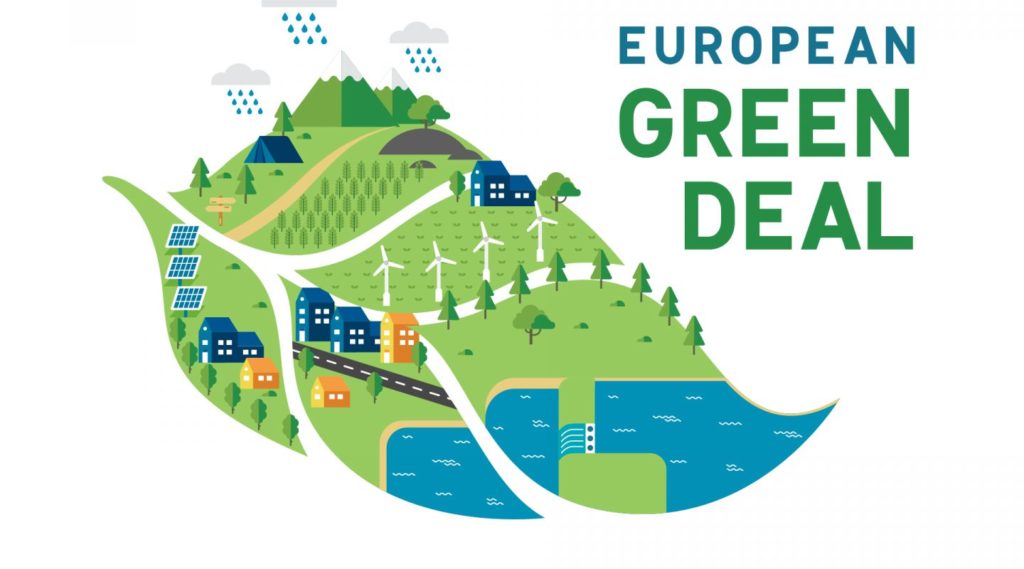How ambitious legislation can pave the way for greater circularity
Policies and regulations play a key role in creating an enabling environment for a circular economy. We conducted an assessment of current legislative trends and developments, and investigated how they will push circularity forward – here in Berlin, on a national level and beyond.

What role does public policy play for a circular economy? Regardless of its topic, policies create certainty. Certainty leads to a safe and future-proof environment for innovation and investments in circularity (Ellen MacArthur Foundation, 2023a). Such innovation and investments then set the right boundary conditions for business developments from linear towards circular value chains. Thus, national governments, regional authorities and international organisations play a crucial role in determining a regulatory framework which promotes the transition to a circular economy (Kazancoglu et al, 2020). So what is currently happening on the policy landscape for a circular economy?
We have analysed the most important policy developments and trends from the past years on a regional, national, and international level. We will highlight both the possible impacts as well as the current gaps that have not been filled, and summarise what big enterprises and small start-ups alike can take away from this.
The EU level – treaties, directives & regulations shaping the circular economy of tomorrow
Since a few years, the European Union (EU) is strongly working to create the right conditions for the circular economy to thrive. One major milestone towards such conditions has been the approval of the European Green Deal, a package of policy initiatives which aim to fulfil the UN’s 2030 agenda. Of particular relevance within this bundle of sustainable policies is the EU’s New Circular Economy Action Plan – in short: CEAP (European Commission, 2023a).

Since its introduction in March 2020, the CEAP has been the framework for a number of ambitious policy proposals, for example, the revision of the Packaging and Packaging Waste Directive, the revision of the rules on waste shipments, or measures to prevent greenwashing. Some of these proposals have already been accepted and turned into binding law for EU member states. With more stringent laws, it is becoming more and more challenging and unattractive for European businesses to follow a linear economy logic – which leads them to incorporate circular systems thinking into their business development (European Commission, 2023b).

Other initiatives empower European consumers – such as the right to repair, which aims to enhance the reusability, repair and remanufacturing of products sold in the EU – making these products more durable and extending their lifetime, while also ensuring that precious materials can be recycled after a product’s end of life. For example, in 2022, eco-design measures for smartphones and tablets were finalised. As one of the measures, producers will be required to release spare parts to consumers for at least 7 years after release of the product (Right to Repair, 2023).
Another important policy development from last year was the adoption of the EU’s Corporate Sustainability Reporting Directive (CSRD). The CSRD builds on the already existing sustainability reporting and puts it to equal importance as financial reporting.
It establishes harmonised reporting criteria for businesses, which achieves plausibility and comparability of data and facts.
With the CSRD, all European companies above the size of 250 employees need to report on how they plan to lower their CO2 emissions, how they strive to achieve circularity within their business, how they protect and recover biodiversity threatened by their business activities, and how they protect human rights. What can be expected is that this directive will require the majority of European businesses to start grapple what circular economy means in their firm’s context. Further, the CSRD has the potential to lead to the initiation of wider change processes within business operations, as private firms will strive to adhere to the reporting requirements, and might even establish a unique selling point through their circularity initiatives (Econsense, 2022).
The national level – how Germany enables circular businesses to thrive
One thing is for sure: The circular economy has arrived on Germany’s political agenda again. In comparison to Germanys’ stellar reputation in the late 90ies due to its progressive waste management policies, progress in the German circular economy has been rather slow in the past 20 years. However, the current government, consisting of the green party, the social democrats and the liberal party, have jointly developed the ‘national circular economy strategy’ in their coalition paper. Under this strategy, the coalition aims to bring forward topics such as a plastic tax for German producers, a digital product pass with comprehensive information on a product’s materials and its supply chain, and standards that ensure recyclability being addressed already in a product’s design stage (IHK Karlsruhe, 2021). There are lots of ambitious targets, especially for the plastic sector, however, with past and present crises, like the corona pandemic and the war in Ukraine, progress going from targets to legislation has been slow.
Nonetheless, there are some important policies and legislations that have a positive impact on the circular economy in Germany. For example, the German institute for standardization has recently published a standardization roadmap for the circular economy. Standards help to create transparency and precision for businesses through harmonization and unification of terminology. Focussing on the key sectors digitalisation & business models, electronics, batteries, packaging, plastics, textiles and construction, the roadmap will give guidance and clarity to businesses and entrepreneurs operating in these sectors (DIN, 2022).

One novel legislation with the potential to disrupt the current dominating linear logic especially in the retail sector is the mandatory offering of reusable packaging. This legislation, in force since January 2023, provides that catering businesses - including delivery services, caterers and self-service counters - must offer reusable packaging as an alternative to single-use packaging (BMUV, 2021). If coupled with consumer awareness and behavioural change campaigns, this legislation might completely turn current supply and demand of single-use packaging around, especially in urban regions. New businesses surrounding washing and reverse logistics services will emerge, and existing ones will be able to gain traction over single-use packaging producers. To unlock cross-industry circularity, similar legislation is needed in other sectors.
The regional level – important policies and initiatives that enhance circularity in Berlin
As a federal state, Berlin has the right to develop legislation only for specific topics – e.g. for education and culture. Most legislative decision-making power lies within the nation state of Germany. As a city, Berlin has limited abilities to set legally binding measures, but can set positive examples and incentives for private businesses and the civil society alike through voluntary initiatives. An example for a circular economy initiative targeting individuals is the initiative Re-Use Berlin. Meeting the urgent need of sustainable resource management, Re-Use Berlin has launched a re-use superstore in the capital, in which second hand products can be donated and find a new owner. The initiative, which was launched by the Senate’s Department for the Environment, Mobility, Consumer and Climate Protection pushes awareness for circularity and has the potential to change consumer behaviour (Re-Use Berlin, 2023).
Key take-aways for private actors
The circular economy is a popular concept among policy makers that will push legislation in favour of resource efficiency, the sharing economy, standardisation and other economic trends we can currently observe. When looking at the EllenMacArthur Foundation’s universal policy goals for the circular economy, we can see that some of them start materialising in the current policy landscape (EllenMacArthur Foundation, 2023b).
So what can businesses, entrepreneurs and start-ups learn from the current legislative developments? One thing is for sure, coming years will see policy focus more and more on the incorporation of circularity already at the design phase of a product or service – so as a business, entrepreneurs have to learn to challenge ownership, and embrace Design4Recycling and Design4Reuse! Further, one must keep in mind resource efficiency and management: It is likely that more and more attention in policies will be laid on how private actors use raw materials – and whether they are of primary or secondary source. Secondary raw materials will be favoured over primary raw materials, and more and more non-circular products will be banned. Another important related topic are pricing mechanisms, which will play an ever-increasing role.
It is likely that primary raw materials will be heavily taxed, and secondary raw materials will be cheaper in the future. So it might be a good idea to future-proof your business by centring your business model around recycled or refurbished materials. Working on a thorough circular business model can also pay off in a more obvious way, as investments in the circular economy will increase – a key trend which can already be observed today, through stricter reporting. And lastly, think collaborative, not competitive – allowing cross-industry knowledge transfer and building initiatives in which different stakeholders work together and share knowledge is the only way to a seamless transition from linear to circular.
Sources
BMUV, 2021. Derived from: https://www.bmuv.de/pressemitteilung/mehrweg-wird-moeglich-im-to-go-bereich/
DIN, 2022. Derived from: https://www.din.de/en/innovation-and-research/circular-economy/standardization-roadmap-circular-economy
Econsense, 2022. Derived from: https://econsense.de/en/aktuelles/new-sustainability-reporting-requirements-the-corporate-sustainability-reporting-directive-csrd-in-brief/
Ellen MacArthur Foundation, 2023a. Derived from: https://ellenmacarthurfoundation.org/resources/government-and-policy/overview
Ellen MacArthur Foundation, 2023b. Derived from: https://ellenmacarthurfoundation.org/universal-policy-goals/overviewEuropean Commission, 2023a. Derived from: https://commission.europa.eu/strategy-and-policy/priorities-2019-2024/european-green-deal_en
European Commission, 2023b. Derived from: https://environment.ec.europa.eu/strategy/circular-economy-action-plan_en
IHK Karslruhe, 2021. Derived from: https://www.ihk.de/karlsruhe/fachthemen/umwelt/abfall/aktuelle-informationen/plaene-der-ampel-koalition-zur-staerkung-der-5356782
Kazancoglu et al, 2020: https://onlinelibrary.wiley.com/doi/full/10.1002/bse.2641
Re-Use Berlin, 2023. Derived from: https://reuse-berlin.de/wofuer-wir-stehen/
Right to Repair, 2023. Derived from: https://repair.eu/de/news/what-2022-brought-for-repair-in-eu-policy-and-what-to-expect-from-2023/
